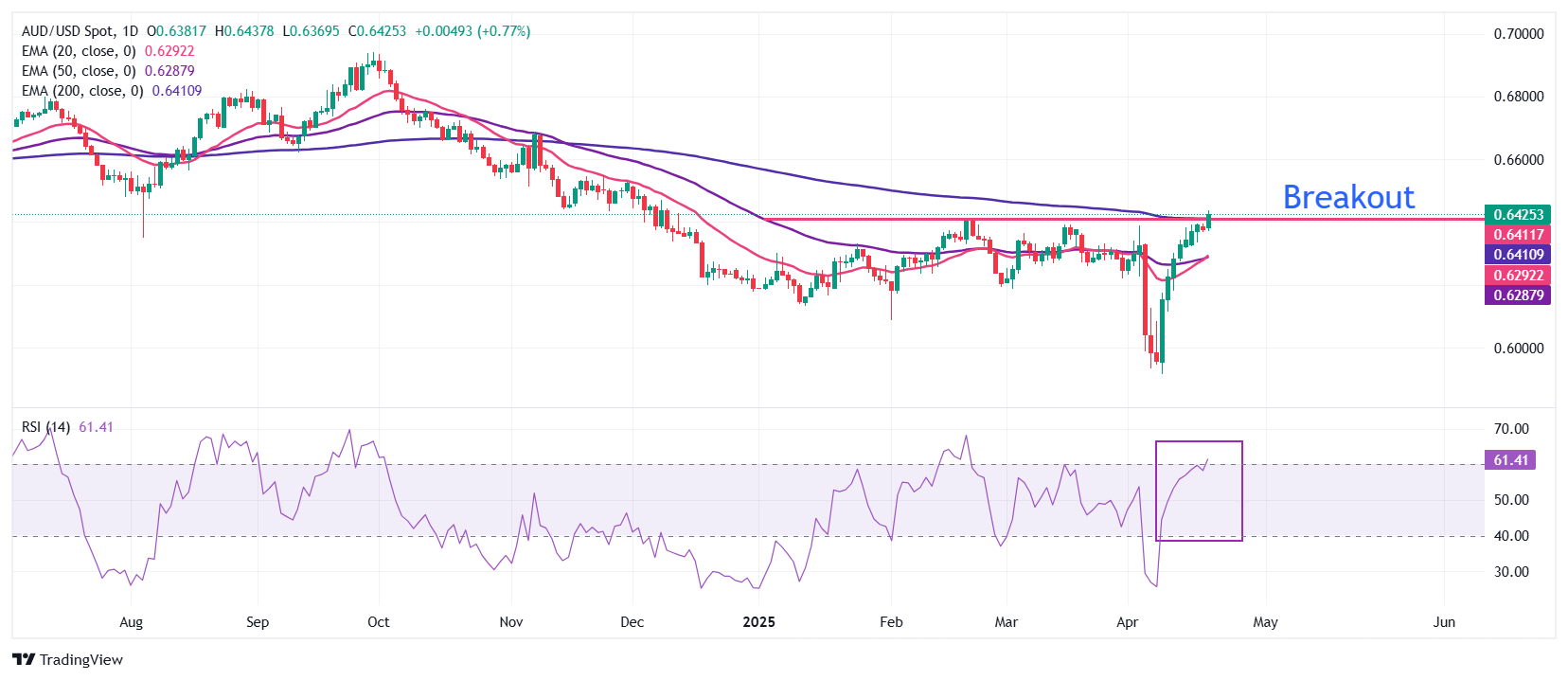AUD/USD Price Forecast: Refreshes four-month high above 0.6400
- AUD/USD jumps to a fresh four-month high above 0.6400 as the US Dollar plummets.
- US President Trump continues to slam Fed Powell for not reducing interest rates.
- Trump’s tariff policies keep the Australian Dollar on its toes.
The AUD/USD pair posts a fresh four-month high above 0.6400 on Monday. The Aussie pair strengthens as the US Dollar (USD) continues to get battered by United States (US) President Donald Trump threatening the “autonomous” status of the Federal Reserve (Fed).
US President Trump has threatened to sack Fed Chair Jerome Powell for not lowering interest rates. On Friday, Trump said, "The Fed really owes it to the American people to get interest rates down. That’s the only thing he’s good for," Trump said. "I am not happy with him. If I want him out of there, he’ll be out real fast, believe me." These comments from Trump came after Jerome Powell stated that the economy is well enough to wait for monetary policy adjustments until the Fed gets greater clarity on how new economic policies will shape the economic outlook.
During North American trading hours on Monday, Trump criticized Powell again for supporting a “wait and see” approach on interest rates. “There can be a SLOWING of the economy unless Mr. Too Late, a major loser, lowers interest rates, NOW,” Trump said through a post on Truth.Social.
Meanwhile, the Australian Dollar (AUD) underperforms its peers, except North American peers, amid uncertainty over trade relations between the US and China. However, Washington expects that there could be a deal between them. “We're confident it will work out with China,” US Commerce Secretary Howard Lutnick said over the weekend.
Given the significant dependence of the Australian economy on its exports to China, the uncertainty over the economic outlook of Beijing weighs on the Aussie Dollar.
AUD/USD breaks above the key resistance of 0.6400 plotted from the February 20 high, which coincides with the 200-day Exponential Moving Average (EMA). A bull cross by the 20- and 50-day EMAs near 0.6285 indicates that the near-term trend is strongly bullish.
The 14-day Relative Strength Index (RSI) climbs above 60.00. A fresh bullish momentum would emerge if the RSI holds above the 60.00 level.
More upside would appear towards the round-level resistance of 0.6500 and the November 25 high of 0.6550 if the pair if the pair breaks above the December 5 high of 0.6456.
On the flip side, a downside move below the March 4 low of 0.6187 towards the February low of 0.6087, followed by the psychological support of 0.6000.
AUD/USD daily chart

Australian Dollar FAQs
One of the most significant factors for the Australian Dollar (AUD) is the level of interest rates set by the Reserve Bank of Australia (RBA). Because Australia is a resource-rich country another key driver is the price of its biggest export, Iron Ore. The health of the Chinese economy, its largest trading partner, is a factor, as well as inflation in Australia, its growth rate and Trade Balance. Market sentiment – whether investors are taking on more risky assets (risk-on) or seeking safe-havens (risk-off) – is also a factor, with risk-on positive for AUD.
The Reserve Bank of Australia (RBA) influences the Australian Dollar (AUD) by setting the level of interest rates that Australian banks can lend to each other. This influences the level of interest rates in the economy as a whole. The main goal of the RBA is to maintain a stable inflation rate of 2-3% by adjusting interest rates up or down. Relatively high interest rates compared to other major central banks support the AUD, and the opposite for relatively low. The RBA can also use quantitative easing and tightening to influence credit conditions, with the former AUD-negative and the latter AUD-positive.
China is Australia’s largest trading partner so the health of the Chinese economy is a major influence on the value of the Australian Dollar (AUD). When the Chinese economy is doing well it purchases more raw materials, goods and services from Australia, lifting demand for the AUD, and pushing up its value. The opposite is the case when the Chinese economy is not growing as fast as expected. Positive or negative surprises in Chinese growth data, therefore, often have a direct impact on the Australian Dollar and its pairs.
Iron Ore is Australia’s largest export, accounting for $118 billion a year according to data from 2021, with China as its primary destination. The price of Iron Ore, therefore, can be a driver of the Australian Dollar. Generally, if the price of Iron Ore rises, AUD also goes up, as aggregate demand for the currency increases. The opposite is the case if the price of Iron Ore falls. Higher Iron Ore prices also tend to result in a greater likelihood of a positive Trade Balance for Australia, which is also positive of the AUD.
The Trade Balance, which is the difference between what a country earns from its exports versus what it pays for its imports, is another factor that can influence the value of the Australian Dollar. If Australia produces highly sought after exports, then its currency will gain in value purely from the surplus demand created from foreign buyers seeking to purchase its exports versus what it spends to purchase imports. Therefore, a positive net Trade Balance strengthens the AUD, with the opposite effect if the Trade Balance is negative.


